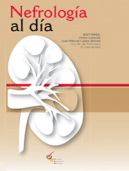Hepatitis C virus infection and chronic kidney disease are major public health issues globally and HCV plays activity in various organs and systems including kidneys. Recent large-scale epidemiological studies have highlighted the negative impact of HCV on the incidence and progression of chronic kidney disease in the adult general population of the western world. In addition, HCV-related glomerular disease is a well-known complication of chronic HCV and novel improvements concerning its management has been achieved. A novel systematic review with meta-analysis reported a strong relationship between HCV infection and higher risk of proteinuria in the general population. Twenty-three studies (n=198,967 unique patients) were identified and overall effect estimate was significant in cross-sectional (OR, 1.47, 95%CI, 1.3; 1.66) (P<0.001) and longitudinal surveys (HR, 1.79, 95% CI, 1.17; 2.74) (P<0.001). The treatment of HCV-related glomerular disease includes now antiviral (direct-acting antiviral agents, DAAs), immunosuppressive and symptomatic drugs. In addition to selective immunosuppression (rituximab, RTX), various combinations of all-oral interferon-free regimens provided with fast and pangenotypic activity is giving us the possibility to treat patients with HCV-related glomerular disease, with and without kidney impairment, and to obtain some clinical benefit. We have collected by a narrative review of the medical literature a cohort of patients (n=104) with HCV-related glomerular disease, the frequency of sustained viral response was 91% (90/99); complete or partial clinical response was found in 29% (n=30) or 42% (n=43), respectively. Recent evidence from a Spanish multicenter survey (n=139 patients with HCV-related mixed cryoglobulinemia) suggests that successful antiviral therapy lowers significantly 24-hour proteinuria, promotes immunological response and improves kidney/patient survival. In conclusion, HCV-related glomerulonephritis remains a difficult-to-treat disease even though the extensive use of DAAs has changed the natural history of HCV and made this disease uncommon.
El factor de impacto mide la media del número de citaciones recibidas en un año por trabajos publicados en la publicación durante los dos años anteriores.
© Clarivate Analytics, Journal Citation Reports 2022
SJR es una prestigiosa métrica basada en la idea de que todas las citaciones no son iguales. SJR usa un algoritmo similar al page rank de Google; es una medida cuantitativa y cualitativa al impacto de una publicación.
Ver másSNIP permite comparar el impacto de revistas de diferentes campos temáticos, corrigiendo las diferencias en la probabilidad de ser citado que existe entre revistas de distintas materias.
Ver más





